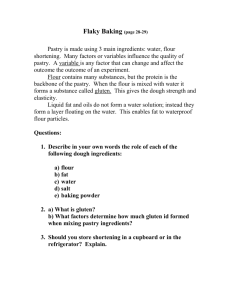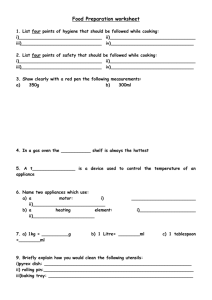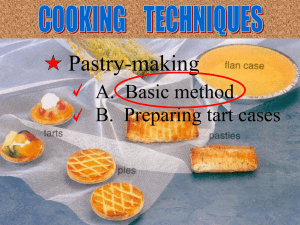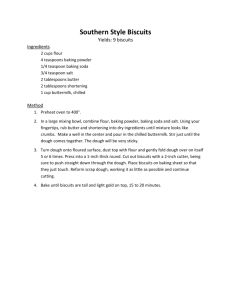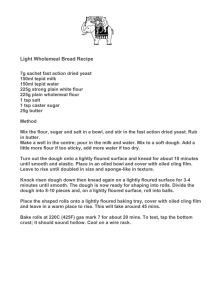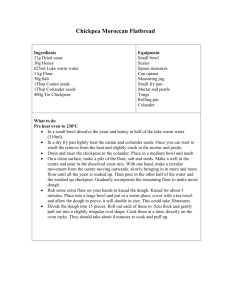eek 6-10
advertisement
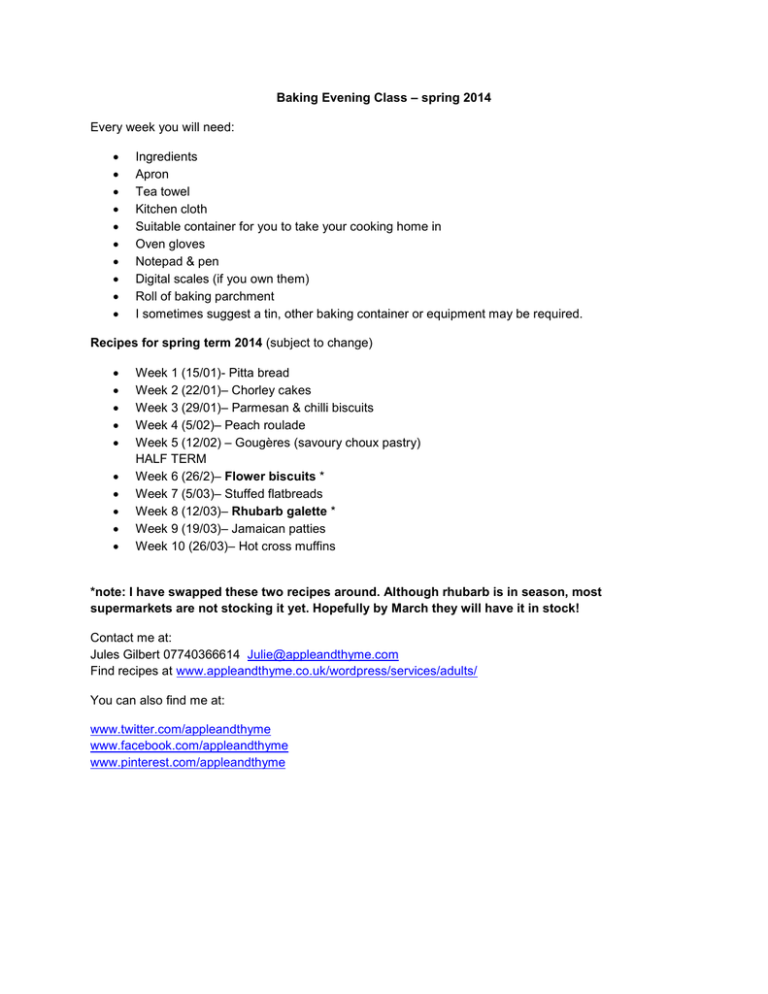
Baking Evening Class – spring 2014 Every week you will need: Ingredients Apron Tea towel Kitchen cloth Suitable container for you to take your cooking home in Oven gloves Notepad & pen Digital scales (if you own them) Roll of baking parchment I sometimes suggest a tin, other baking container or equipment may be required. Recipes for spring term 2014 (subject to change) Week 1 (15/01)- Pitta bread Week 2 (22/01)– Chorley cakes Week 3 (29/01)– Parmesan & chilli biscuits Week 4 (5/02)– Peach roulade Week 5 (12/02) – Gougères (savoury choux pastry) HALF TERM Week 6 (26/2)– Flower biscuits * Week 7 (5/03)– Stuffed flatbreads Week 8 (12/03)– Rhubarb galette * Week 9 (19/03)– Jamaican patties Week 10 (26/03)– Hot cross muffins *note: I have swapped these two recipes around. Although rhubarb is in season, most supermarkets are not stocking it yet. Hopefully by March they will have it in stock! Contact me at: Jules Gilbert 07740366614 Julie@appleandthyme.com Find recipes at www.appleandthyme.co.uk/wordpress/services/adults/ You can also find me at: www.twitter.com/appleandthyme www.facebook.com/appleandthyme www.pinterest.com/appleandthyme Week 6 -Flower Biscuits (makes 20-30) 220g butter, softened 200g caster sugar 1 tsp vanilla bean paste (or vanilla extract/essence) 1 egg, large 425g plain flour Red gel paste Green gel paste (I will bring my food gel pastes with me that you are welcome to borrow, traditional watery food dye won’t work with this recipe) Baking parchment 1. Cream together the butter and sugar. Add the egg and the vanilla bean paste and beat well. 2. Add the flour and work together into a dough. 3. Divide into 3 portions. Working with one at a time lightly flour the work surface and gently knead the dough until it is smooth and pliable. At first the mixture may appear dry but keep kneading. 4. Set aside 3/4 of the biscuit dough and divide the remaining into 3. 5. To colour each of these flatten out the dough, add a little amount of gel paste colouring the centre, gather the dough up to enclose the colour in the middle and start to knead gently to disperse the colour. Knead until the colour is evenly dispersed throughout the dough. If the colour is too pale add in a touch more gel paste and knead again. 6. Colour one portion green, for the leaves and two portions pink, one slightly paler than the other just by adding less or more of the pink gel paste. Set the colours to one side, wrapped in clingfilm or in a plastic bag so they don’t dry out. 7. Roll out portions of plain biscuit dough on your work surface, keep it lightly floured to make sure the dough doesn’t stick. 8. Cut out circular biscuits (I use a 7cm cutter) and transfer to a tray lined with baking paper or a non-stick liner. Take a slightly smaller circular cutter (I use a 6cm cutter); position it evenly on the biscuit and press down lightly – not to cut through the biscuit just to imprint the circle. For the flowers Roll a ball in the palm of your hand. Roll the ball into a long sausage. Using the forefinger of your opposite hand press down the length of the sausage, just on one side to make it thin. Now from one end start to curl up the sausage, the thin side is the petals outer edge. Roll it up, fairly loosely around the top edge of the flower until you get to the end. Using a pair of scissors or knife, snip the excess off the base of the flower, this will give it a flat base to sit on. Whilst the flower is still sat on the blades of the scissors you can transfer it over to the biscuit and set it down roughly where you want it. You won’t need water to stick it down. For the leaves Roll a ball of green in the palm of your hand. Flatten it with your fingertip. Pinch one end to form the leaf shape. Using a knife mark a line down the centre of the leaf to create the vein. 9. Once you’ve decorated all your biscuits put the tray into the fridge to chill for 30 minutes to firm up. 10. Preheat the oven to 190c (fan)/200c/Gas Mark 6. 11. Check that the dough of the flowers is firm and then bake in the oven for 6-8 minutes. Keep an eye on them as they bake, turning the tray around mid-bake if they are browning too much on one side. 12. They should just be very lightly golden. If over baked then the flowers and leaves will take on too much of a golden tinge too. 13. Allow to cool on the tray for 10 minutes before transferring to a wire rack to cool completely. Week 7 – Stuffed Flatbreads Makes 6 It’s up to you which filling you want to make For the dough: 500 g plain flour 60 ml extra virgin olive oil 200 ml warm water For the cheese filling: small bunch (15g) fresh parsley, chopped small bunch (15g) mint leaves, chopped small bunch (15g) dill, chopped 200 g feta cheese, crumbled For the chorizo filling: 200g chorizo, sliced 50g grated cheese like gouda or emmenthal 1. For the dough: sift the flour and a teaspoon of salt together into a large bowl. Make a well in the centre, pour in the olive oil then gradually stir in enough water to make a nice ball of dough. 2. Turn the dough onto a floured surface and knead for about 5 minutes, or until smooth and elastic. Split the dough into six equal balls and leave to rest under a tea towel for an hour. 3. To make the herb and feta filling: Mix the parsley, mint and dill with feta in a bowl and add a pinch of black pepper. 4. To make the chorizo and cheese filling: Mix the chorizo and grated cheese in a separate bowl. 5. Lightly dust a surface with flour and use the longest rolling pin in the house to roll each dough ball out as thinly as possible into a rectangular shape – somewhere round to around 30cm x 40cm. 6. For each flatbread, fold the top third down towards you to cover the middle third. Fold the bottom third up to cover the middle third too so you have a long rectangle. Add one of the fillings to one half of the rectangle – you can be generous, but be careful not to overfill them. 7. Brush the edges with water then fold the other half of the pastry over the filling ingredients, pressing it down lightly all over, especially at the edges. Repeat this until you have three of each filling. 8. Heat a wide frying pan over a medium heat and cook one or two at a time in a dry pan for 3-4 minutes both sides until browned and crisp. Week 8 – Rhubarb and Apple Galette Note: I have moved this recipe to further in the course in the hope that more places will be stocking rhubarb by April. In Feb the only place I could buy rhubarb is Sainsbury’s. If you can’t find rhubarb, replace with apple. For the pastry: 50g caster sugar 75g butter 75g lard 340g plain flour For the filling: 2 tbsp flour 90g caster sugar 2 tbsp ground almonds 2 apples, peeled and sliced 300g fresh rhubarb, cut into 3cm pieces 2 tsp cinnamon 1 egg Baking parchment 1. First make the pastry. Mix the sugar with the flour then rub in the butter and lard until it resembles breadcrumbs. Add cold water a tablespoon at a time until you have a nice dough. Cover in clingfilm and chill for 30 min. 2. Heat the oven to 200ºc and place two large baking trays in to heat. 3. Meanwhile, mix 1 tbsp each of the flour and caster sugar with the ground almonds. Put to one side. 4. Mix the remaining flour and sugar with the apples, rhubarb and cinnamon. 5. Take the chilled pastry and split into 6 pieces, roll each into a circle. Fill the centre of each with the almond sugar and top with the fruit. 6. Bring the edge of the pastry up and around the fruit. Pinch the pastry together around the edges to form a crust. Brush with egg. 7. Transfer the galettes to the hot baking trays and cook for 35min or until golden and crisp. Jamaican Patties Makes 6 For the pastry: Juice of 1 lemon Good pinch of saffron or turmeric (I will bring turmeric with me) 300g plain flour 150g ground almonds Pinch of salt 250g butter 2 eggs (1 for pastry, 1 for glaze) For the filling: 2 tbsp olive oil 1 onion, finely chopped 2 garlic cloves, finely chopped 400g minced lamb/beef/quorn 2 tbsp curry powder (I will bring some with me. I don’t recommend using curry paste) 1 tbsp tomato puree 150g peas 200g plain yoghurt Small bunch of coriander, chopped 1 egg Salt & pepper Some seeds like fennel, cumin or sesame to decorate (optional) 1. First make the pastry. Pour the lemon juice over the saffron and leave to steep. Put the flour, almonds and salt into a bowl and rub in the butter until it resembles breadcrumbs. 2. Add the saffron mixture, then one of the eggs and bring together as dough. Cover in clingfilm and chill for 30min while you make the filling. 3. Heat the oil in the pan, add the onions and garlic and cook gently for 5-10 minutes. Add the meat and cook until browned. Stir in the tomato puree, curry powder and peas. Cook for a further 1-2 min then take off the heat. Stir in the yoghurt and coriander. 4. Roll out your pastry until about 3mm thick and cut out 6 rounds about 25cm in diameter. Divide the filling between these pastry circles, brush the edges with beaten egg then fold over to make semi-circles. Use a fork to help crimp the edges. Make a small hole in the top of each one to help steam escape. 5. Place the patties on a lined baking sheet and bake for 10-20 minutes. Week 10 – Hot Cross Muffins Makes 10 450g strong white bread flour ½ tsp salt 50g butter, softened 7g sachet easy-blend (fast action) yeast 2 tsp ground mixed spice 50g caster sugar finely grated zest 1 lemon 275ml/9fl oz milk, (you probably won’t need all of this) 2 eggs, beaten 200g mixed dried fruits For the crosses and glaze 2 tbsp plain flour golden syrup, to glaze Tulip muffin cases (they sell these in Sainsbury’s) or baking parchment. I will show you how to make tulip cases. 1. First put crack your eggs into a measuring jug and top up to the 300ml mark with milk. 2. Put all dough ingredients, except the dried fruit in a bowl and mix together until all the ingredients are well combined. Knead for 8-10 minutes. It is quite sticky, don’t worry. 3. Once the dough is ready, turn it out onto a lightly floured surface. It is quite sticky at this stage, but resist the urge to add too much flour. Pat into a large flat circle, tip the fruit in the centre and enclose with the dough. Knead the fruit in to distribute the fruit evenly. 4. Cut out nine 14cm squares of baking parchment and have ready a 12-hole muffin tin. Cut the dough into 9 even-sized pieces and roll each into a smooth ball. Push a square of the parchment into a tin hole and drop in a ball of dough. Repeat with the rest. 5. Cover the tin loosely with lightly-oiled cling film and leave in a warm place for 30-45 minutes or until doubled in size. Preheat oven to fan 180C/ conventional 200C/gas 6. 6. For the crosses, blend the flour to a smooth paste with 5-6 tsp of cold water. Spoon into a small plastic food bag and cut a small hole off one corner or use a piping bag. Pipe crosses on the buns. Bake for 15 minutes or until golden. Lift onto a cooling rack. Brush with a little golden syrup while warm.
